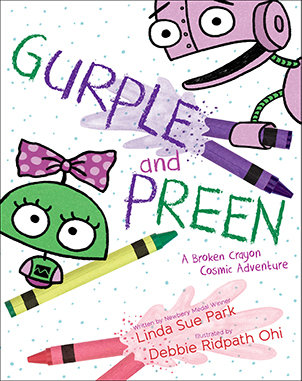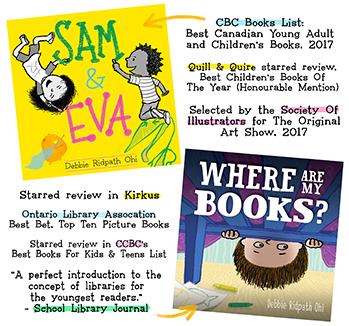Writing Collaboration Profile: Cheryl O'Donovan and Tom Wolferman
This week's column is about writing collaboration for two reasons. Reason #1: I collaborated with Michelle West to co-author a short story for a DAW fantasy collection called Magic Tails and am in the early stages of possible book collaboration, so am especially interested in this topic right now.
I recently found out that writer/cartoonist Chery O'Donovan and writer Tom Wolferman co-authored The Estrogen Underground (A Better Be Writer Publisher, 2005), described on their Web site as "subversive humor for the woman over forty." Reason #2 for this column: It's my birthday today, and Cheryl's and Tom's book title definitely caught my eye for its relevance. :-)
Anyway, Cheryl and Tom kindly let me pick their brains about their collaboration process:
 |
How did you and Tom decide to collaborate?
Cheryl:
I can’t recall how the quote goes…something like, “Dying’s easy, comedy’s hard.” Doing comedy alone is hard. There’s no laugh track to measure that your humor’s working. I’d met Tom through a mutual business contact. We corresponded over the years with humorous and philosophical e-mails. I knew he had talent.
I felt “The Estrogen Underground” as a concept had merit, and knew he could help deliver something funny and insightful. We’re both older, too, more inclined toward Mad magazine, “The Daily Show” and old Dick Van Dyke reruns, and relate less to stuff like “South Park.”
Tom:
Cheryl and I had worked with a mutual business contact, but not directly with each other. We began corresponding via email and realized we shared similar interests in writing. Our senses of humor also were aligned. After several years of volleying humorous emails, Cheryl contacted me for feedback when she hatched the idea for "The Estrogen Underground: Reinvention." When a publisher responded to her query and samples, she asked if I'd be interested in collaborating on the book. Although we never had a prior working relationship per se, there was an existing comfort level and mutual respect.
What was the collaboration process? (e.g. how did you decide who did what, how much was in-person, by phone, e-mail etc.)
Cheryl:
Because this was our first collaboration ever, the process was a little scrambled and hectic – and heavily electronic. After creating a working outline, we each took sections. Tom would write up a section, e-mail it. Back at my home office, I’d illustrate and design, as well as write. Occasionally, we’d do phone calls. I’d often be working at 3:00 a.m., cackling like some madwoman in a cellar.
Sometimes, the whole loony process was hilarity in itself. In our e-mail subject lines were questions about female werewolves and Hollywood plastic surgeons. Far from normal. But we never claimed to be normal.
Tom:
Cheryl had a vision for the book from the start. She wanted the writing to be smart; the humor spoofy, but not crude or demoralizing. I've always shared that sensibility so it was a project that intrigued me. She also wanted portions of the book's humor to touch readers on a more personal level, through essays. We agreed that a somewhat self-effacing tone would allow the reader to better relate to us. Once a publisher was on board, Cheryl put together an outline of chapters and topics.
Based on this blueprint, I started feeding her a few additional concepts, ideas for satiric content, etc. Once the chapters were finalized, we then chose specific sections we thought we'd each have fun tackling. Because the book was targeting baby boom women, as self-described "token male" I was apprehensive at first in being able to find a voice in my personal essays that would be relevant to this audience.
The key was choosing topics that were authentic for me. Our collaboration took the form of emails and occasional phone conversations. Since we had never met prior, by the time the project moved forward we both agreed we would delay meeting in person until the book was completed. It makes for a quirky story. Our first momentous face-to-face encounter was at an American Airlines departure gate en route to the Texas Book Festival, prior to removing our shoes for security purposes.
 |
What problems did you encounter collaborating this way, if any? How
did you solve these problems, or at least get around them?
Tom:
Surprisingly, there were few problems in the collaboration process. I think if there is mutual respect between collaborators, and both are secure in their talents and abilities, it is possible to create a working relationship where sharing suggestions is not viewed as a personal attack. Though we are similar in work ethic and creative approaches, we don't always agree. That would be unrealistic. But we attempt to be honest with each other. We'll lobby for ideas we feel strongly about. But respectfully, without an agenda.
When it comes to the creative process, Cheryl is probably a better multi-tasker. She can juggle tirelessly. I like to focus on a topic, then move on to the next. We try to adapt to each other's styles. After years writing in business settings, advertising agencies and corporate environments, we've both had experience working as part of creative teams. They can be infested with high drama and self-serving motives. If you're both looking to create something for the good of the project, not personal ego, it can be a healthy, satisfying collaboration.
Cheryl and I are confident as writers, but somewhat ego-deprived. Neither one of us has any particular need to stand alone in the spotlight. Actually, either one of us is more likely to shove the other into the spotlight, breathe a sigh of relief, and wave happily from the sidelines. We are reluctantly learning how to navigate the rapids of self-promotion.
Cheryl:
By talking it out. We can disagree on what’s funny or effective. When that happens, we try to get an objective ("third party") opinion. We don’t ask for cotton ball feedback, either. We want people to be candid, if not brutally honest.
It’s hard sometimes, especially when deadlines loom. Under pressure, I can do a brain-freeze, and veer toward panic. Even then, you’ve got to stop, breathe and give each other space, if just for a few hours.
Finally, it’s also how you say it. Tact is a good thing. Tom and I have an appreciation for diplomacy, having both toiled under dictatorships. (Just kidding)
 |
What are the advantages of collaborating?
Cheryl:
Writing is an isolationist sport. As they say, you can’t write a novel by committee. However, you can become too insular. As collaborators, you’re not working in a vacuum. Creative people run the risk of becoming too self-satisfied, especially if they have success. For me, an overblown ego is the kiss of death. Once you think your stuff is untouchable, that’s when the inevitable decline begins.
People think they work best with people who are identical to them. What happens in that scenario? Usually the same old stuff. Think classics like Sid Caesar’s “Your Show of Shows” were written by the same flock of birds? No. Tom and I are different. Our styles complement each other. At least, that’s what it says in our press release.
Tom:
I think the advantages of collaboration are the excitement of conceiving an idea, building on it, shaping it, and ultimately developing it into something that breathes. It's the fun of the creative process, feeling free to bounce around ideas in the brainstorm stages, even the most ridiculous, eye-rolling concepts. If the give-and-take is safe, the results can be rewarding. And for those who loathe the publicity process, collaboration is the way to go.
We've had a blast promoting the book through online audio recordings, at the Texas Book Festival and at a recent signing at Barnes & Noble. I don't think it would have been nearly as fun going solo. The support really makes a difference. The camaraderie gets you through the rough spots.
What advice do you have for writers who are considering a collaboration project?
Tom:
I would say take some time to get to know the person. Set realistic goals. Talk about how you prefer to work. Give it a trial run and see how it goes. Have grounded expectations. Don't expect to agree, but agree to give and take. Let ideas marinade. It's all part of the process. And keep your sense of humor. Oh, and you'll want to know in advance what your collaborator looks like if you plan on meeting for the first time at an airport security checkpoint.
Cheryl:
Have some flexibility. Early on, discuss how you’ll resolve conflict, because they’re unavoidable. Listen to your collaborator’s opinions on your work, and vice versa. Respect how he or she works. I’m a tad ADD, and create in a cloudburst. Tom’s more methodical. So, everyone’s different. Some people get their engines revved in a group brainstorm. Others first work solo, then get together to discuss ideas.
You can find out more information about the book, including excerpts, at their Web site.
If anyone out there has other advice to offer on writing collaboration (do's and don'ts), please do post them below!
 cheryl o'donovan,
cheryl o'donovan,  collaboration,
collaboration,  interview,
interview,  tom wolferman in
tom wolferman in  Blog/news
Blog/news 





